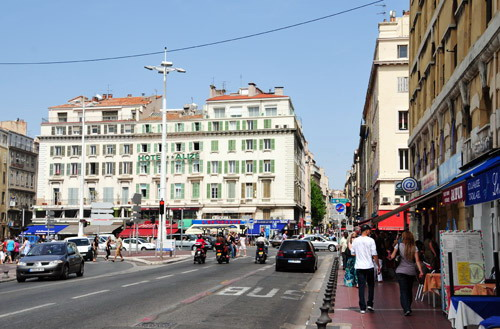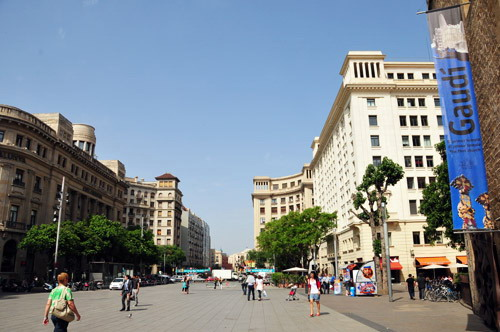When Sustainability is No Longer a Proper Noun
Tue, Jul 21, 2009 Albert Lam Albert Lam, Sustainable Design, Green Roofs, Architecture, Integrated Design, Sustainable Lifestyle
One of my favorite pastimes when visiting Europe is strolling through the cities, taking in the architectural ambiance and unraveling the dense urban fabric of each locale. The spatial texture of the narrow, bending roads, the sudden relief of public plazas, and the bustling activity of restaurants and boutiques all present delightful discoveries. A vivacious sense of street life and activity always seems to permeate throughout each district, often even into the later hours of the night. And while not every street is crowded with pedestrians, there always seem to be people around.  Having grown up in the Los Angeles metropolitan area-a sprawling land with countless drab, detached strip malls, island mega shopping centers, and zoning that carefully segregates habitation, occupation, and recreation-I find the sense of intimacy that even the largest European cities possess to be thrillingly uplifting. Having been woven through centuries of organic growth and local concentration, their urban texture is highly conducive toward the intermingling of people, because everything is together at once. In this seemingly effortless manner, European architecture and planning innately incorporate many concepts of sustainable design. This results in an environment where sustainability equals normalcy.
Having grown up in the Los Angeles metropolitan area-a sprawling land with countless drab, detached strip malls, island mega shopping centers, and zoning that carefully segregates habitation, occupation, and recreation-I find the sense of intimacy that even the largest European cities possess to be thrillingly uplifting. Having been woven through centuries of organic growth and local concentration, their urban texture is highly conducive toward the intermingling of people, because everything is together at once. In this seemingly effortless manner, European architecture and planning innately incorporate many concepts of sustainable design. This results in an environment where sustainability equals normalcy.
Consider some of the trendy concepts of green architecture. "Mixed Use" occupancy is often promoted as a catch phrase to help advertise a development's diversity, but to Europeans, this practice has always been done without a special name. It simply makes sense to have people work and play near where they live for convenience sake. Rating systems like LEED place value on proximity to public transportation and amenities to lessen dependence on automobiles, items that are easily fulfilled by the density and infrastructure of most European cities. Green roofs and use of local materials are common in many sites, because their advantages are logical to pursue. Even some small towns have recycling services set up-something that many metropolises in America lack. What's striking, however, is how all of this comes off as unexcitingly normal. In Europe, there appears a lesser need to market aspects of sustainability as though they were innovative advances, because they are already accepted ways of life. Part of this is due to necessity-most cities developed before automobiles, an advent that could have allowed residents to spread out over a wide area, and thus stayed dense. Plus, energy and natural resources are costlier than they are in America. Regardless of the cause, this has propagated the habit of integrating high sustainable standards into the daily routine. Being green isn't special; it is simply what is done.
What's striking, however, is how all of this comes off as unexcitingly normal. In Europe, there appears a lesser need to market aspects of sustainability as though they were innovative advances, because they are already accepted ways of life. Part of this is due to necessity-most cities developed before automobiles, an advent that could have allowed residents to spread out over a wide area, and thus stayed dense. Plus, energy and natural resources are costlier than they are in America. Regardless of the cause, this has propagated the habit of integrating high sustainable standards into the daily routine. Being green isn't special; it is simply what is done.
None of this scrutiny is intended to join any environmental badmouth parade on America. We are certainly headed in the right direction when it comes to awareness and acceptance of environmentally beneficial practices. Nevertheless, I believe that our objective shouldn't just be to treat sustainability as a noble ambition, but to embrace it as a way of life-to make it normal. My travels and observations have reinforced my belief that sustainable practices can never be add-on checklists or half-hearted attempts to join fads. They must be woven into popular acceptance. This means adopting holistic strategies and making integrated sustainable design the default, not the bonus. And while many companies, such as LPA, already embrace these philosophies, we could always use more who engage in the same.
This will definitely take time, but I have faith it can be done. If sustainability can one day be the standard thing to do, then we and our built environments will be better off for it.
Albert Lam is a Project Coordinator at California-based LPA Inc. He is a LEED accredited professional who specializes in the design and implementation of K-12 schools.